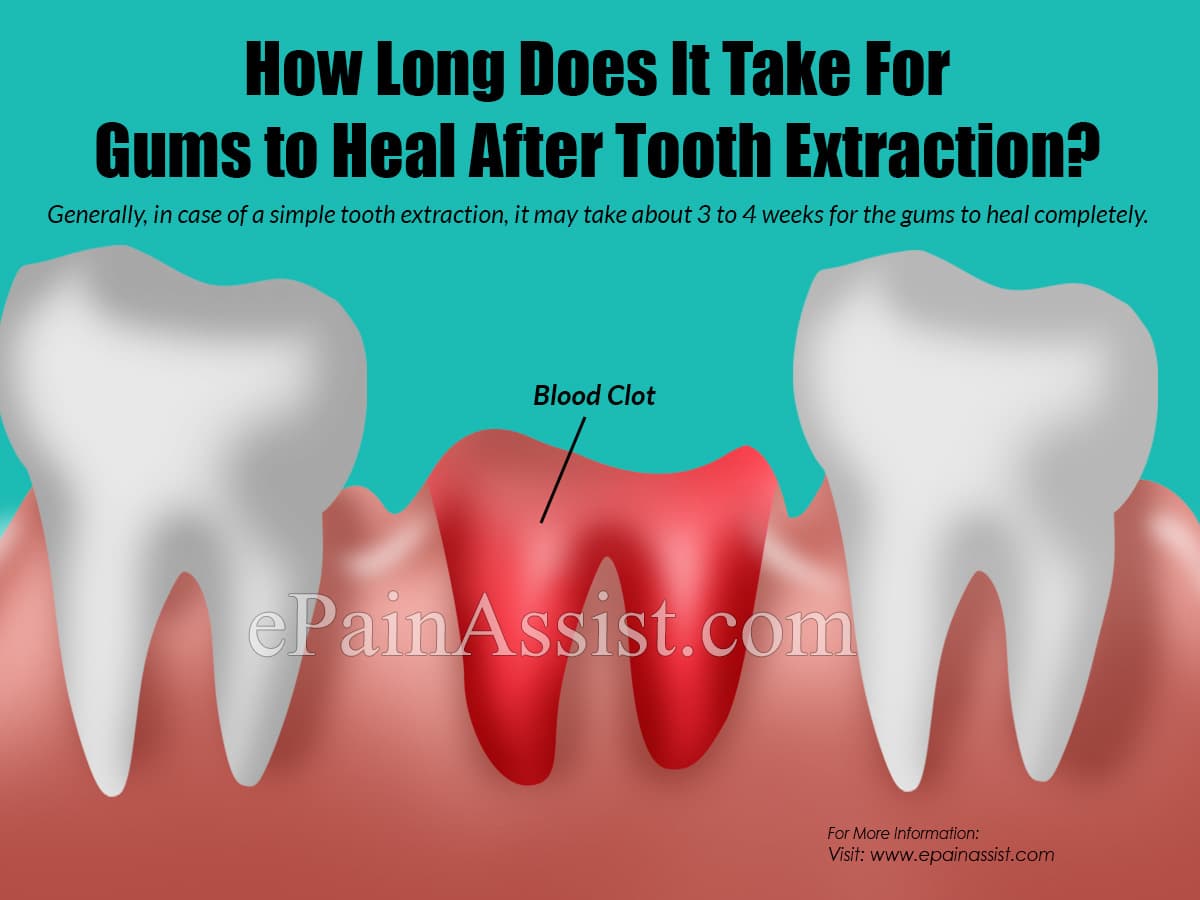Tooth extraction is a procedure of taking off the tooth from the gum. After the completion of the procedure, the site of removal should be healed up fast to avoid further problems like bleeding or infection. The recovery period for gums to heal varies from individual to individual and also as per the procedure done to extract the tooth.
How Long Does It Take For Gums to Heal From Tooth Extraction?

Generally, in case of a simple tooth extraction, it may take about 3 to 4 weeks for the gums to heal completely.1 In case of surgical extraction the bones are to be healed up without undergoing any complication. It may take up to 5 to 6 months for this process.
The Process and Duration of Healing of Gums After Tooth Extraction
The duration and the rate of healing process after a tooth extraction vary from patient to patient. In spite of that, the sequence that is seen during recovery period in a normal individual 1 and the duration which is generally observed in them are explained here.
- Changes During First 24 hours After Tooth Extraction. The blood which is oozing out from the wound fills the socket formed after extraction and then clots. Formation of such a clot is necessary and is actually the first step of healing process. As soon as the clot forms, the oozing out of blood will be stopped. The person starts feeling comfortable gradually as the time passes but the tenderness of the site still remains. In this stage the patient is advised to avoid strenuous exercises and activities which would otherwise increase bleeding and prolong healing. The patient can continue with the daily schedules without engaging in strenuous activities. Swelling which was not there starts to appear. At the same time, formation of new tissue in the gum can be expected.
- Changes in First Two Weeks Following Tooth Extraction. The repairing of tissue has been progressed significantly. The discomfort and inconvenience will be vanished and the patient would be familiar with the shape and position of the gum.2 This period is mostly enough for a simple extraction. For a surgical extraction, the closure of the socket and growth of new tissue takes longer time. The adult cells or mesenchymal cells form and further grow into more specific and differentiated tissue like bone tissue. This part of the wound which is under the process of healing would be supplied with blood vessels and will be tender. Poking, pricking, brushing roughly or hurting it can easily start bleeding.
- During 3rd and 4th Week of Tooth Extraction. Even during this period, indentation is observed to a small extent. In case of removal of many teeth, this indentation is common and is seen till several months. The granulated tissue that is formed in the socket is gradually replaced by the adult cells and almost half of it would be done during this period. Simultaneously, the mesenchyme cells begin to change into bone tissue. This process starts from the base of the socket and the sides. Hence, the shape of the site of extraction would be shallow and narrow. Some activities like brushing the teeth including that area is allowed as the tenderness gradually disappears. Foods that are too hard are to be avoided in this stage also in case of long incision.
- Changes after 4th Week of Tooth Extraction. Even though the formation of bone tissue in that area begins in the first week itself, the complete formation may take 4 months and sometimes take up to 5 to 6 months. The X-ray image provides a proof of complete development of new bone by 4 months after surgery. During this period, one has to take care about the trapping of food particles and the remains in the healing area which is common. Since these developments have taken place, the jaw bone gets a permanent shape which is different from the previous one. Shrinking of alveolar ridge takes place and it may be up to 60% approximately. The length of the cut decides the shape of this alveolar ridge. Longer cuts have more changes and the smaller ones have simple changes. The resorption speed is more in the first month and the rate goes on decreasing with time. Ultimately, resorption will be taking place throughout one’s lifetime but the speed is very negligible say about 1 % in one year. In fact, while it is getting cured, simultaneously the doctor arranges for dentures, partial dentures, dental bridges and/or dental implantation.
What are the Factors on which Healing of Gums After Tooth Extractions Depend On?
Though 3 to 4 weeks are normally required for healing of the gums, the process differs from person to person depending on several factors, some of which are listed below:
- Age of the person
- Health condition of the person (if the person is diabetic or not)
- In case the person is under any anti-coagulant medication already
- Size of the wound
- Genetic characters related to healing of wound
- Any infection occurring at the site
- The instructions followed by the patients properly or not
- Activity or exercise performed by the patient which slows down the healing process.
Conclusion
Post operative care is very important in the tooth extraction procedure. Patient has to take care against the trauma or any kind of infection at the site of cut. Diet modification is required for some days to prevent the risk of complications. Regular follow ups with dentist are required and advices should be taken. Moreover, it is very essential to follow the instructions given by the dentist.
- https://www.ncbi.nlm.nih.gov/pmc/articles/PMC5089986/
- Dimitrova-Nakov S., Baudry A., Harichane Y., Kellermann O., Goldberg M. (2014). Pulp stem cells: implication in reparative dentin formation. J. Endod. 40, S13–S18. 10.1016
Also Read:
